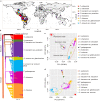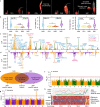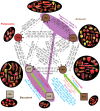Genomes of cultivated and wild Capsicum species provide insights into pepper domestication and population differentiation
- PMID: 37679363
- PMCID: PMC10484947
- DOI: 10.1038/s41467-023-41251-4
Genomes of cultivated and wild Capsicum species provide insights into pepper domestication and population differentiation
Abstract
Pepper (Capsicum spp.) is one of the earliest cultivated crops and includes five domesticated species, C. annuum var. annuum, C. chinense, C. frutescens, C. baccatum var. pendulum and C. pubescens. Here, we report a pepper graph pan-genome and a genome variation map of 500 accessions from the five domesticated Capsicum species and close wild relatives. We identify highly differentiated genomic regions among the domesticated peppers that underlie their natural variations in flowering time, characteristic flavors, and unique resistances to biotic and abiotic stresses. Domestication sweeps detected in C. annuum var. annuum and C. baccatum var. pendulum are mostly different, and the common domestication traits, including fruit size, shape and pungency, are achieved mainly through the selection of distinct genomic regions between these two cultivated species. Introgressions from C. baccatum into C. chinense and C. frutescens are detected, including those providing genetic sources for various biotic and abiotic stress tolerances.
© 2023. Springer Nature Limited.
Conflict of interest statement
The authors declare no competing interests.
Figures





References
-
- Hernández-Pérez T, Gómez-García M, del R, Valverde ME, Paredes-López O. Capsicum annuum (hot pepper): an ancient Latin-American crop with outstanding bioactive compounds and nutraceutical potential. A review. Compr. Rev. Food Sci. Food Saf. 2020;19:2972–2993. doi: 10.1111/1541-4337.12634. - DOI - PubMed
-
- Djian-Caporalino, C., Lefebvre, V., Sage-Daubèze, A.-M. & Palloix, A. Capsicum. Genetic Resources Chromosome Engineering & Crop Improvement (ed. Singh, R. J.) 186–232 (CRC Press, 2006).
-
- D’Arcy, W. G. & Eshbaugl, W. H. New world peppers [Capsicum—Solanaceae] North of Colombia: a resume. Baileya19, 93–105 (1974).
-
- Moses M, Umaharan P. Genetic structure and phylogenetic relationships of Capsicum chinense. J. Am. Soc. Hortic. Sci. 2012;137:250–262. doi: 10.21273/JASHS.137.4.250. - DOI
Publication types
MeSH terms
Substances
LinkOut - more resources
Full Text Sources
Other Literature Sources
Miscellaneous

